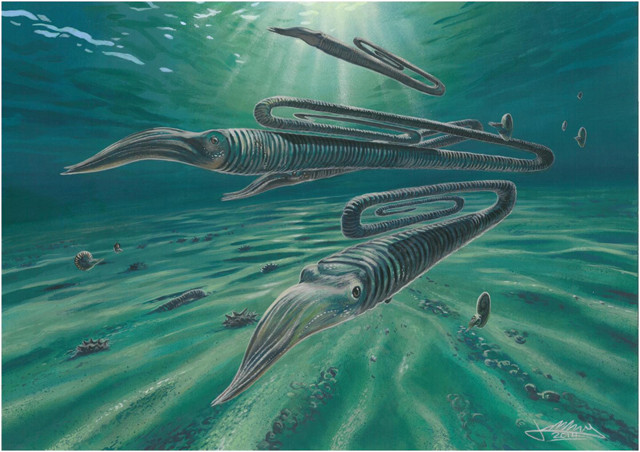
by Mary Caperton Morton Tuesday, September 20, 2016

Artist's rendering of a typical Cretaceous marine environment in Antarctica, including the paperclip-shaped "heteromorphy" ammonite Diplomoceras. Credit: James McKay (jamesmckay.info).
The end-Cretaceous extinction is famous for killing off the dinosaurs, but many other species perished as well. A new study in Nature Communications of marine fossils found in the Antarctic indicates that the extinction event was just as deadly for creatures in the polar regions.
Scientists have previously speculated that organisms living in the Arctic and Antarctic may have been relatively safe during the extinction — either far enough away from the asteroid impact in the Gulf of Mexico and ongoing flood basalts in India, or perhaps resilient enough to withstand the severe climatic changes they induced, since polar creatures would have already been adapted to living in annual long-term darkness.
But the new survey of more than 6,000 marine fossils, including snails and clams as well as ammonites and large marine reptiles ranging in age from 65 million to 69 million years old, shows a dramatic decline in the number of species living in the Antarctic 66 million years ago. This coincides with when the dinosaurs and many other groups of organisms worldwide went extinct.
“Our research essentially shows that one day everything was fine — the Antarctic had a thriving and diverse marine community — and the next, it wasn’t. Clearly, a very sudden and catastrophic event had occurred on Earth,” said lead author James Witts of the University of Leeds in England in a statement. “This is the strongest evidence from fossils that the main driver of this extinction event was the after-effects of a huge asteroid impact, rather than a slower decline caused by natural changes to the climate or by severe volcanism stressing global environments.”
© 2008-2021. All rights reserved. Any copying, redistribution or retransmission of any of the contents of this service without the expressed written permission of the American Geosciences Institute is expressly prohibited. Click here for all copyright requests.